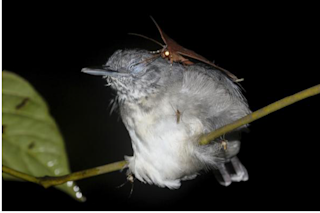In what is perhaps the strangest update we’ve heard from ecologists in a while, a Brazilian researcher has documented – on video – a moth feeding on the tears of a sleeping bird.
The researcher, Leandro João Carneiro de Lima Moraes from the National Institute of Amazonian Research, was conducting amphibian and reptile surveys in the Brazilian Amazon last November when he noticed the behavior – twice in one night – and got it on camera.
Though a human observer might be tempted to consider this behavior somewhere between gross and creepy, the observation might not be terribly surprising from a biological standpoint.
Moths have been fairly well documented sipping on crocodile tears (turtle tears are also fairly common), and there have been a few previously recorded observations of moths drinking from the eyes of birds.
But the moths aren’t just thirsty and kind of weird; there are a handful ...














